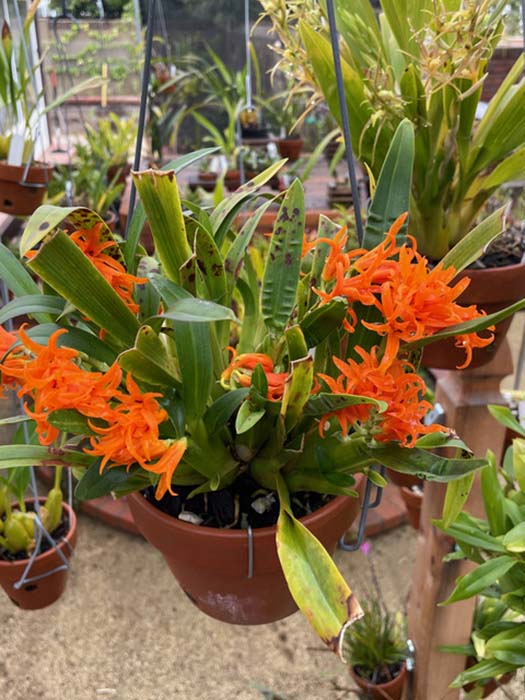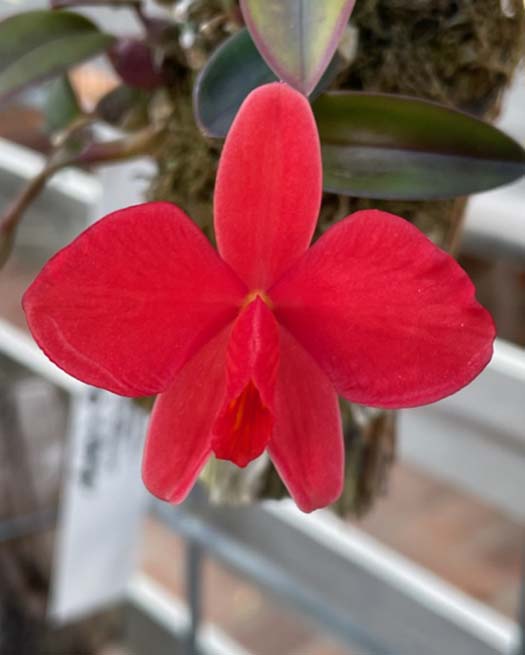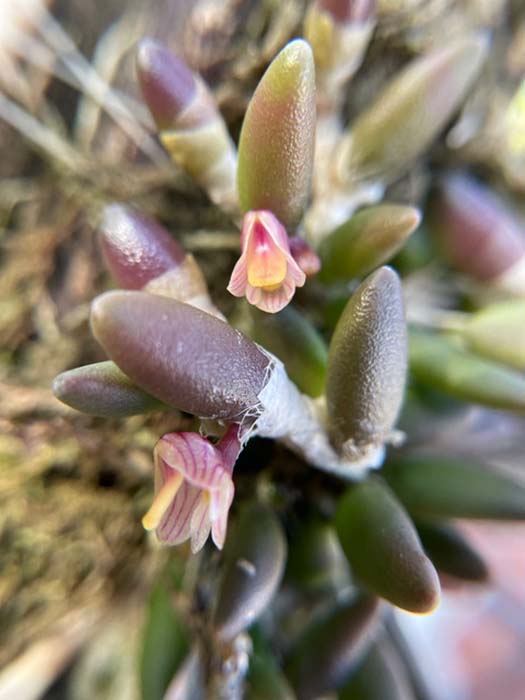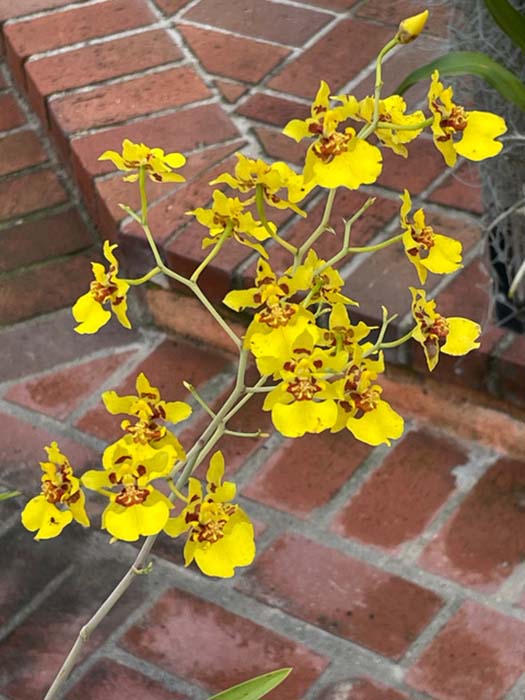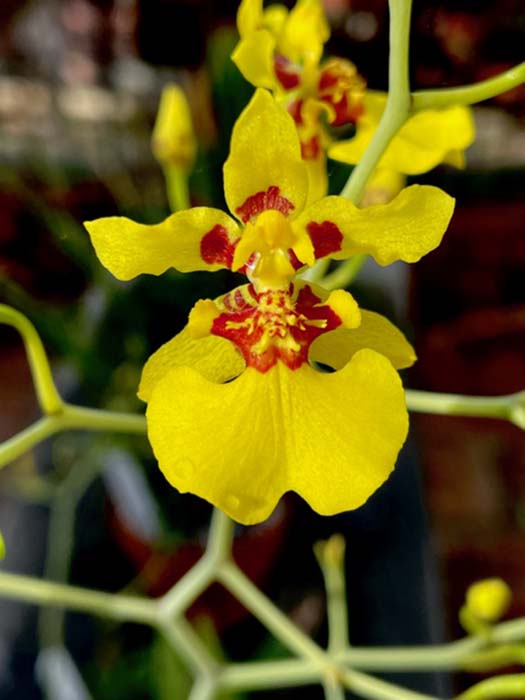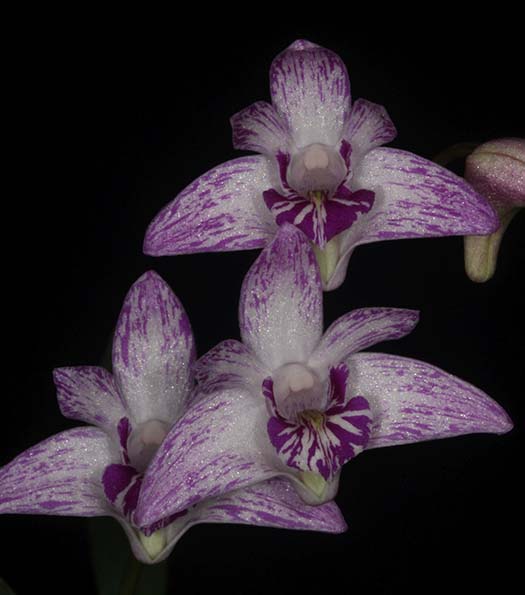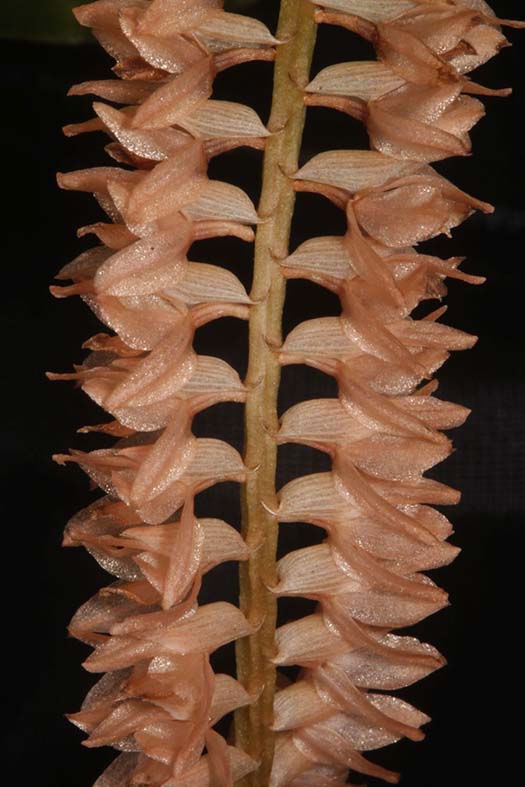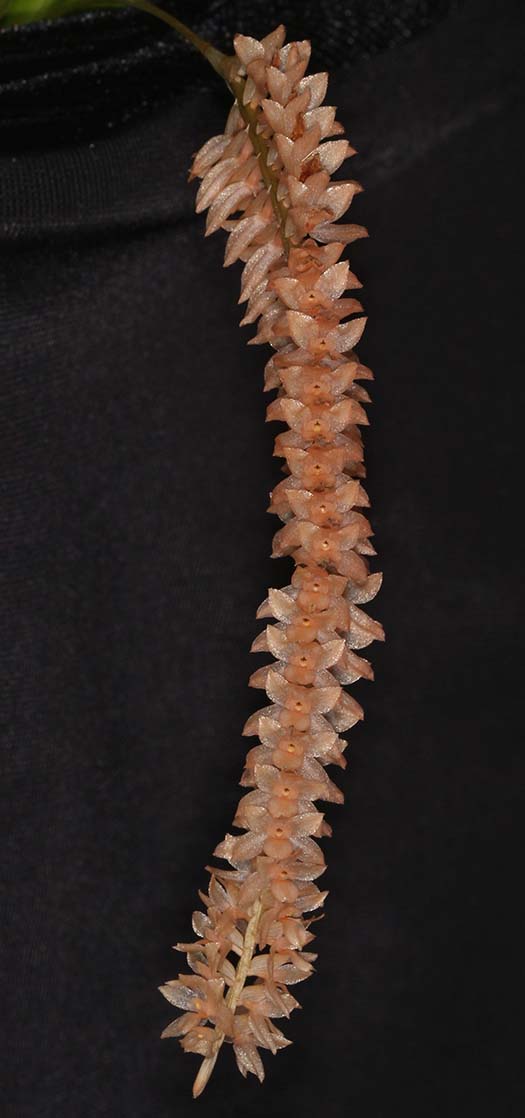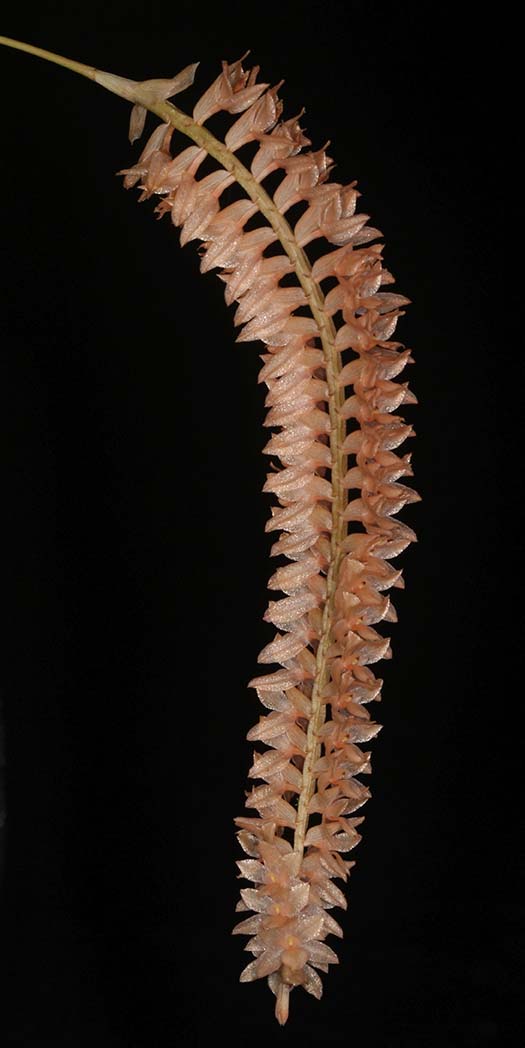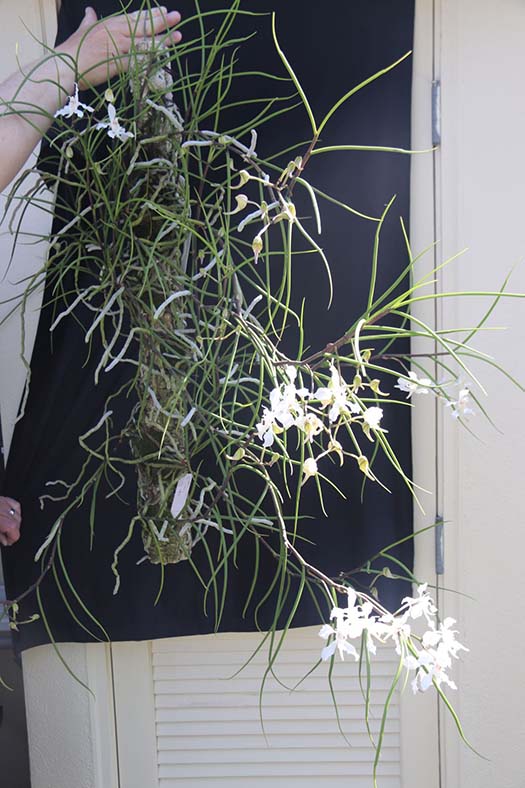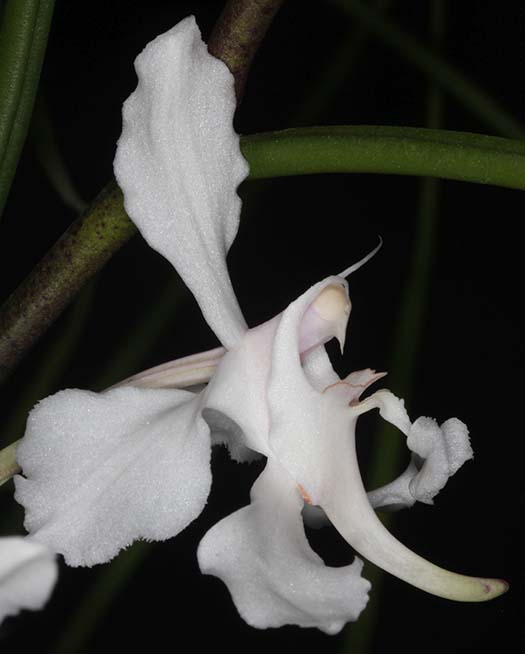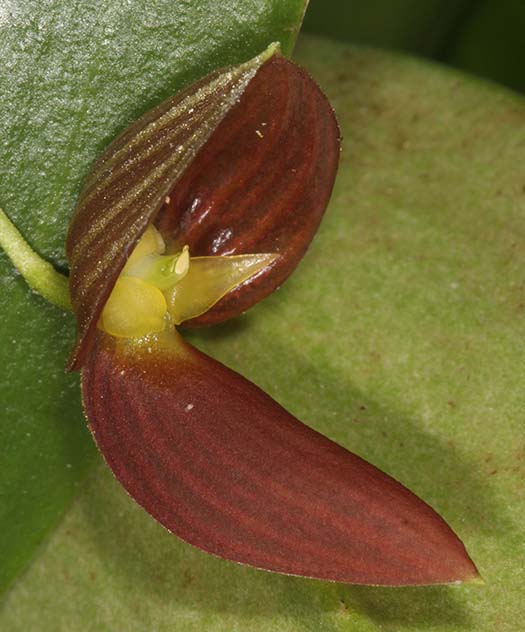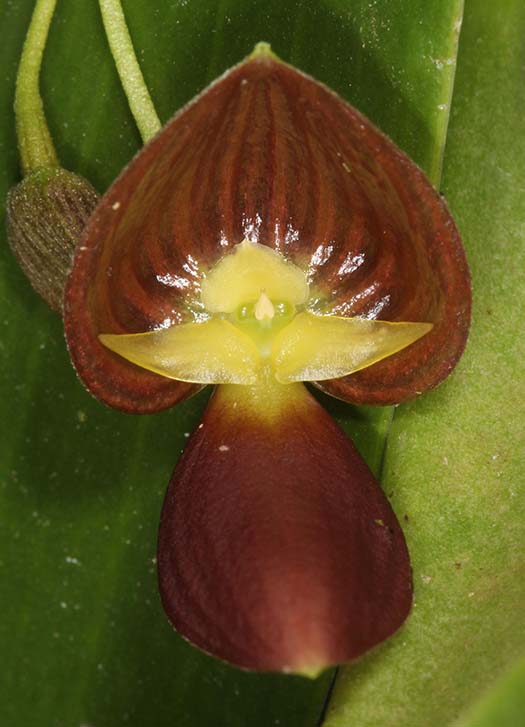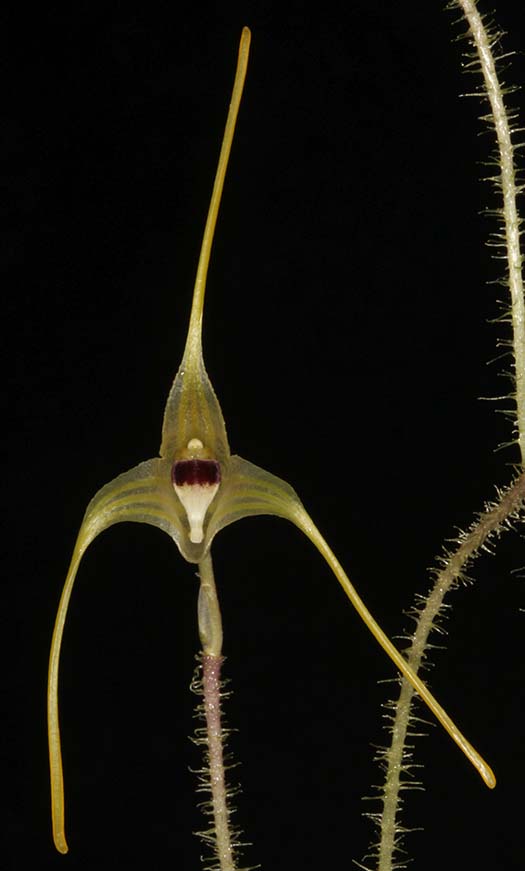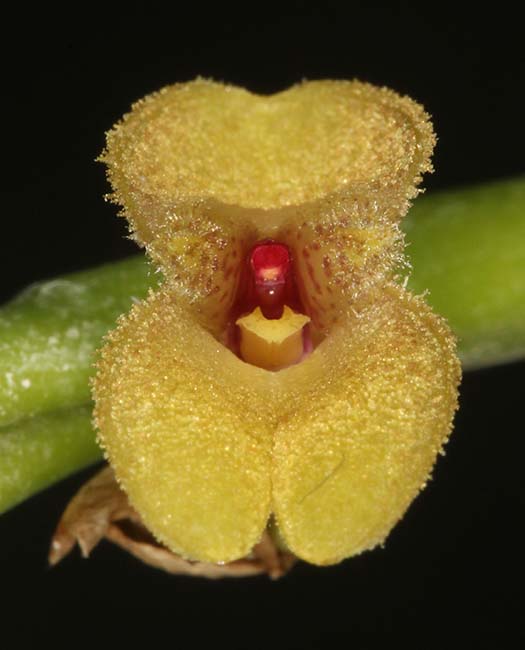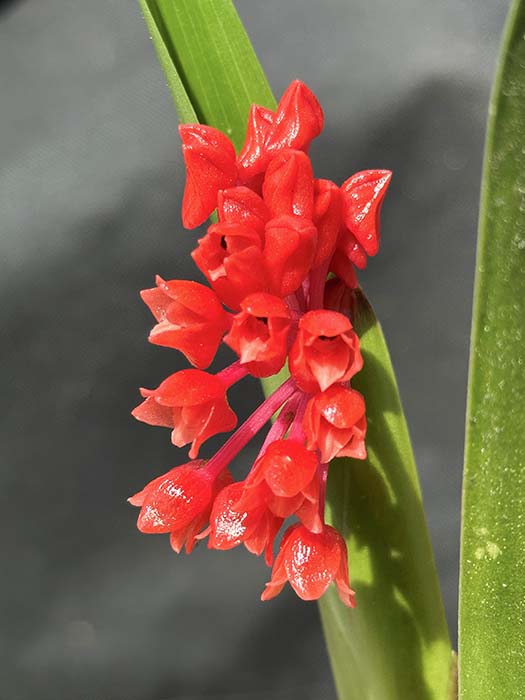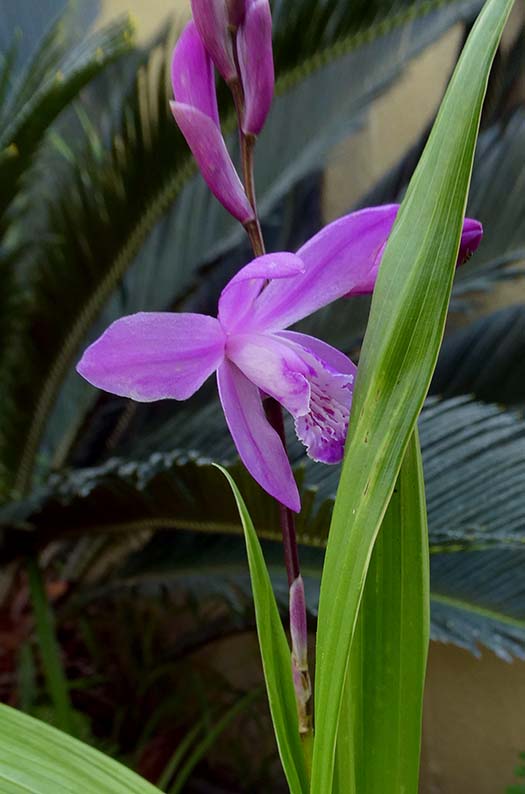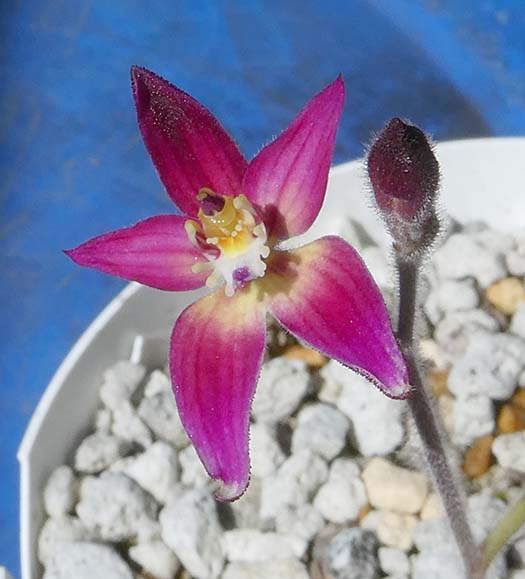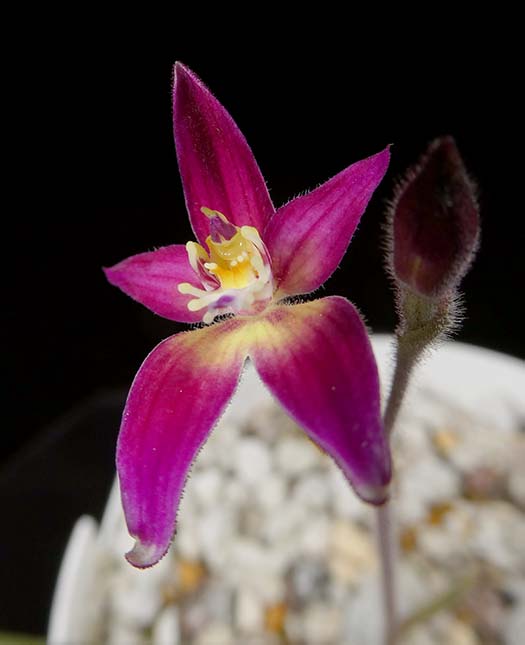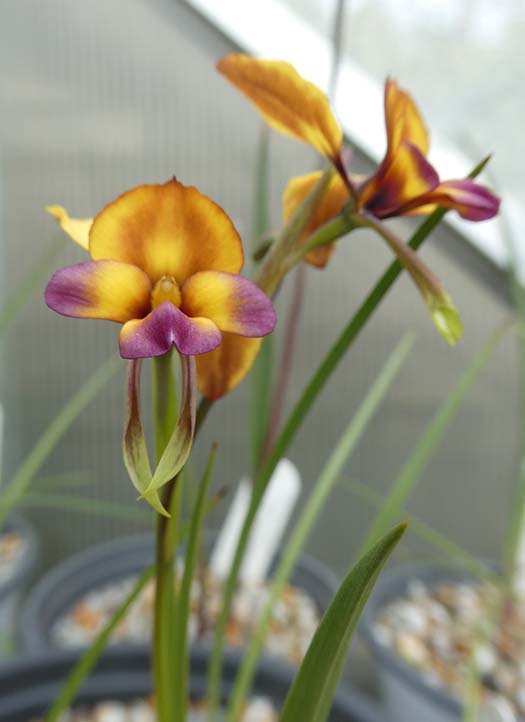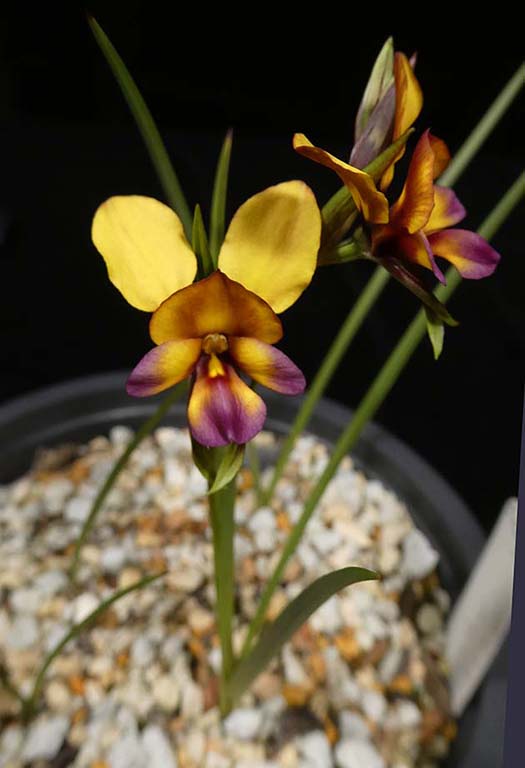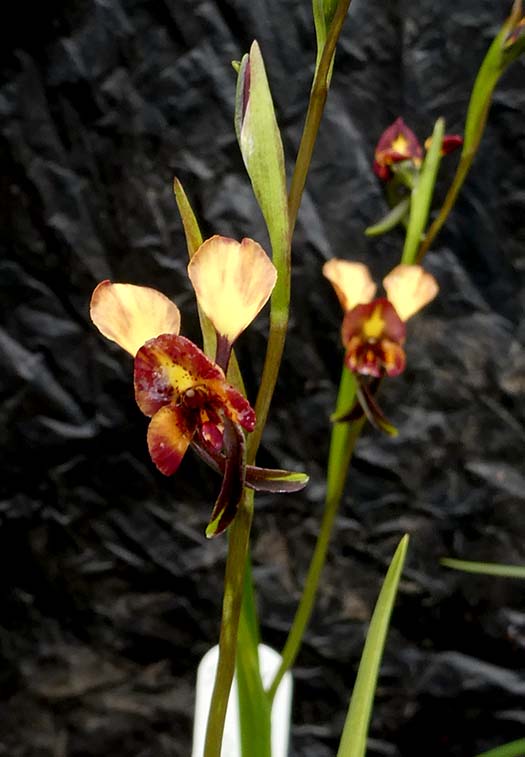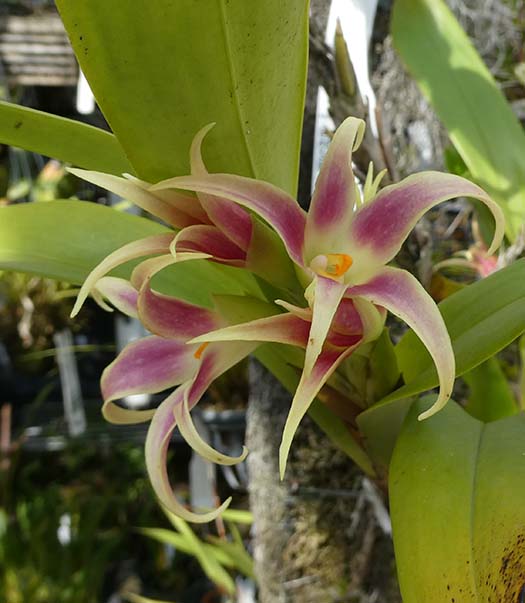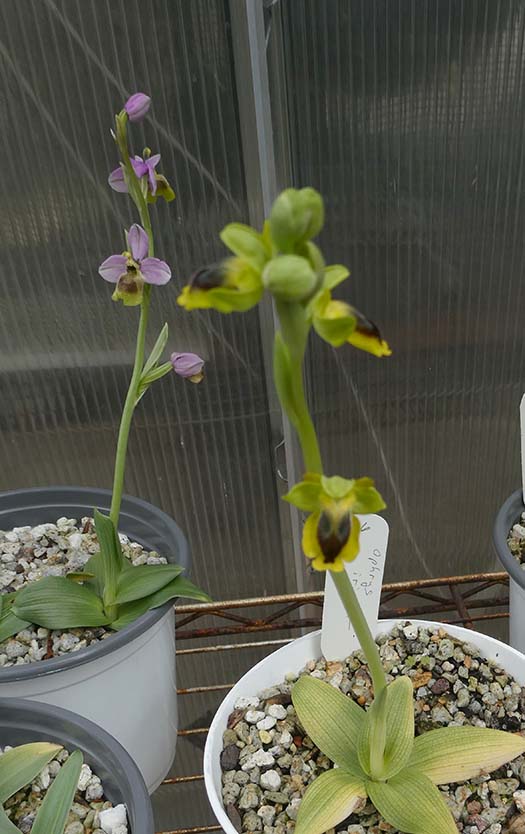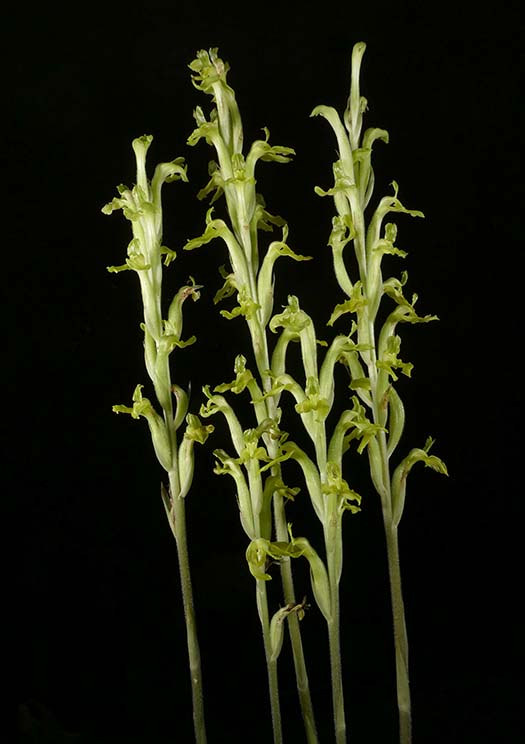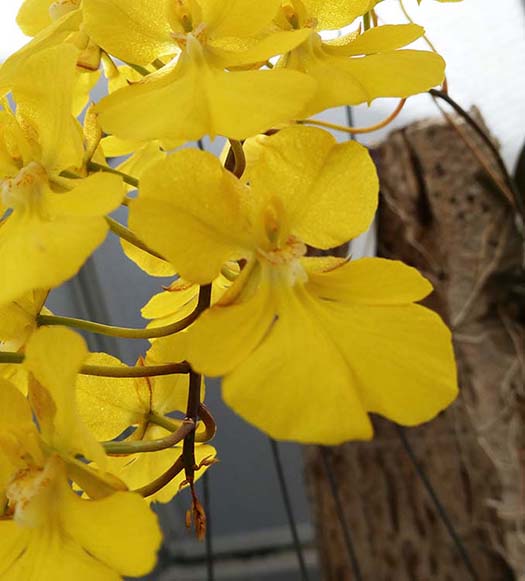April 2023
From Kurt Shanebeck:
|
|
Outdoors coastal, north of Los Angeles: |
|
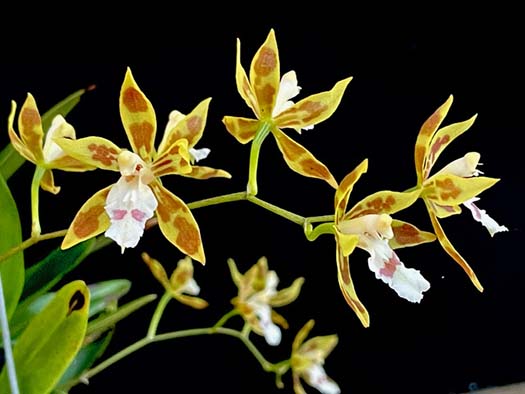
Oncidium constrictumGrowing potted in moss with moderately bright light. Blooms several times a year. |
|
Oncidium lykaiosaiiAn epiphyte native to Bolivia. Growing potted in bark with partial shade. |
|
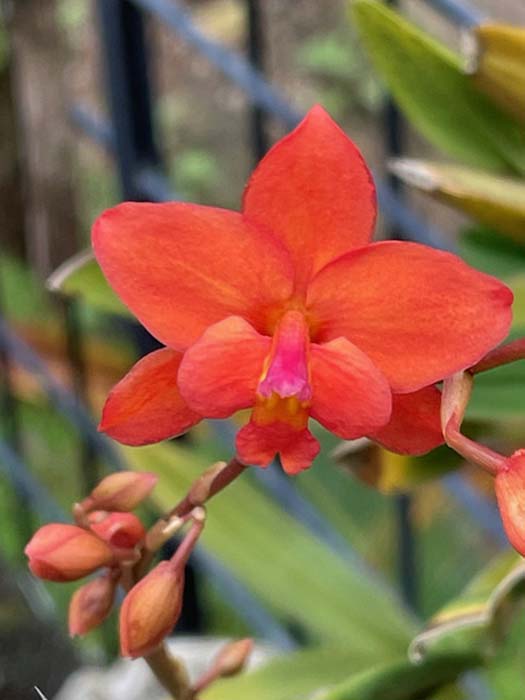
Oncidium noezlianumNative to the cloud forests of Peru and northern Bolivia. Growing mounted with moderately bright light. |
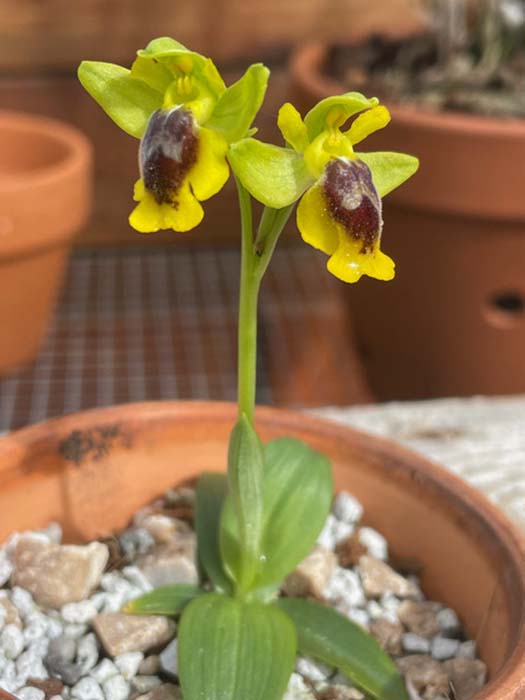
Ophrys luteaBought as Ophrys sphedodes. Suprise! European terrestrial growing in pumice with ~20% coconut coir. |
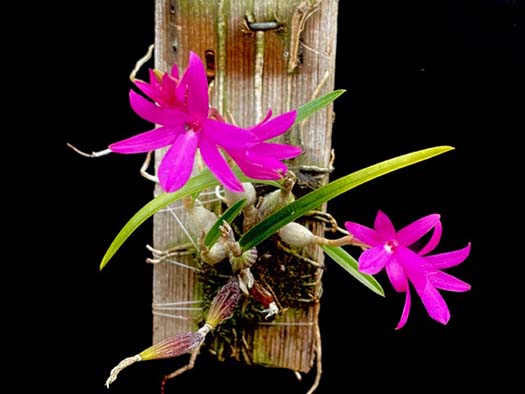
Sophronitella (Isabelia) violaceaNative to Brazil. Growing mounted with bright light. |
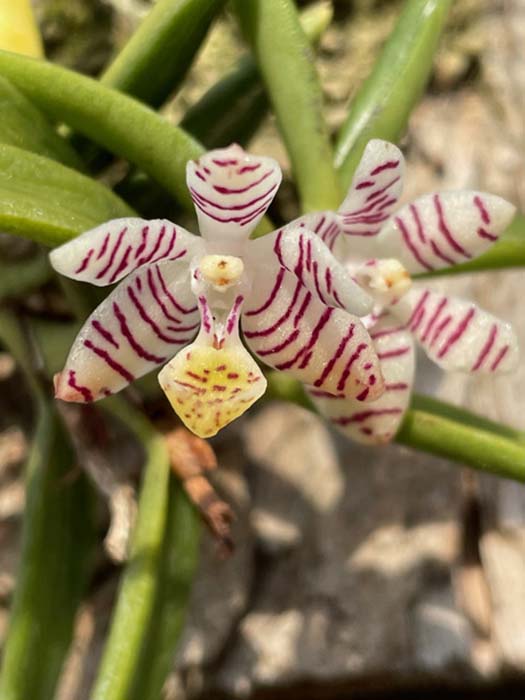
Trichoglottis pusillaNative to Java at elevations to 2000m. Growing mounted with bright light. |
Indoors, under lights: |
|
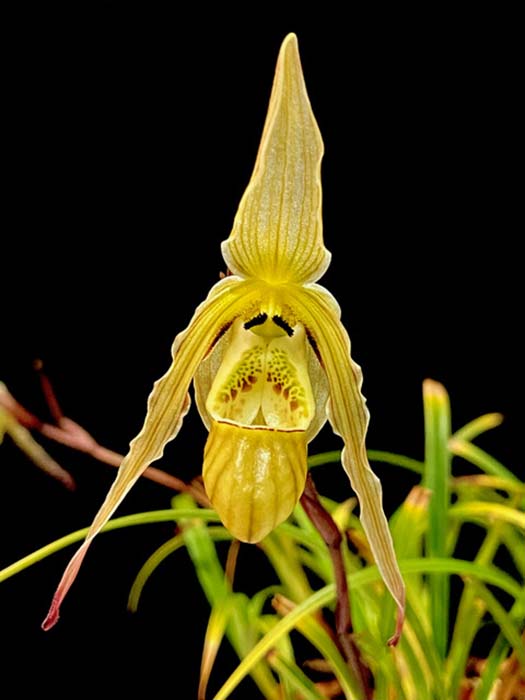 |
Phragmipedium pearceiSouth American terrestrial species often found near rivers. A sequential bloomer. Growing potted in bark with bright light and frequent water. |
From Chris Ehrler:
|
|
Coastal, California Central Coast |
|
Dendrobium kingianum 'Betsy' HCC/AOSThis species is a cool to warm growing lithophyte found in Queensland and New South Wales Australia at elevations of 50 to 1200 meters. This orchid has been successfully grown in either bark or sphagnum moss in clay or plastic pots and either in a cool greenhouse or outside on the north side of the house. Thus, this species is relatively easy to grow. This is the first orchid that Chris Ehrler had awarded by the AOS judges and the clone was named after his wife, Betsy. |
|
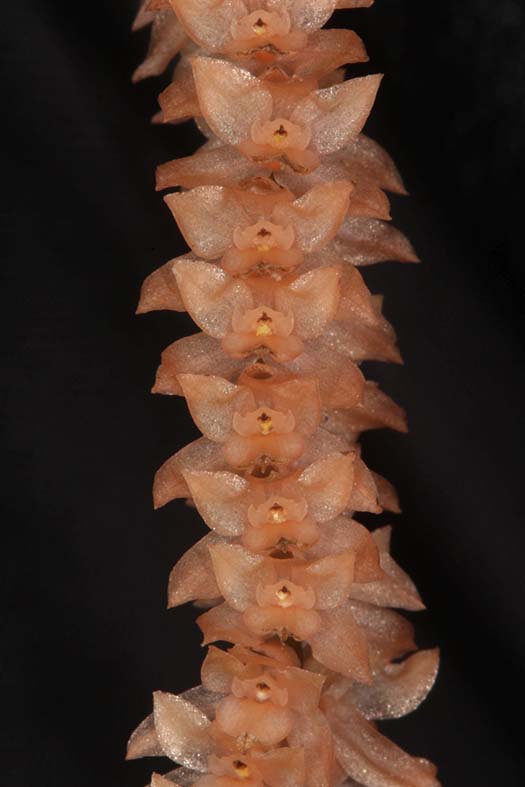 |
|
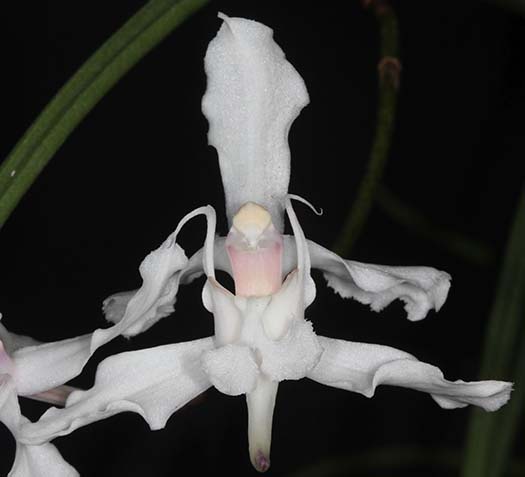 |
|
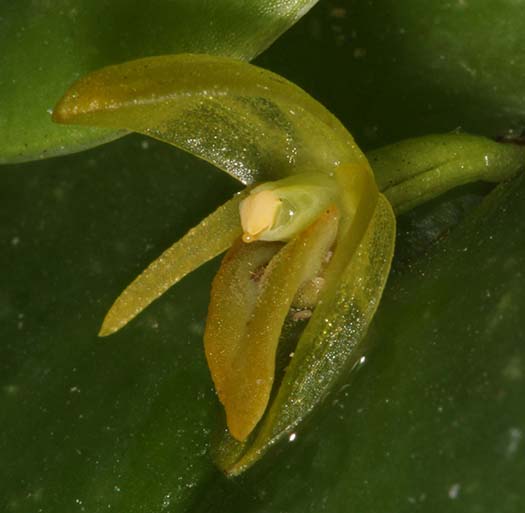
Pleurothallis spp.An unknown Pleurothallis species. Flowers are about 1/4 inch in size. Growing in a clay pot filled with a mixture of bark and lava rock which is placed in a cool greenhouse |
|
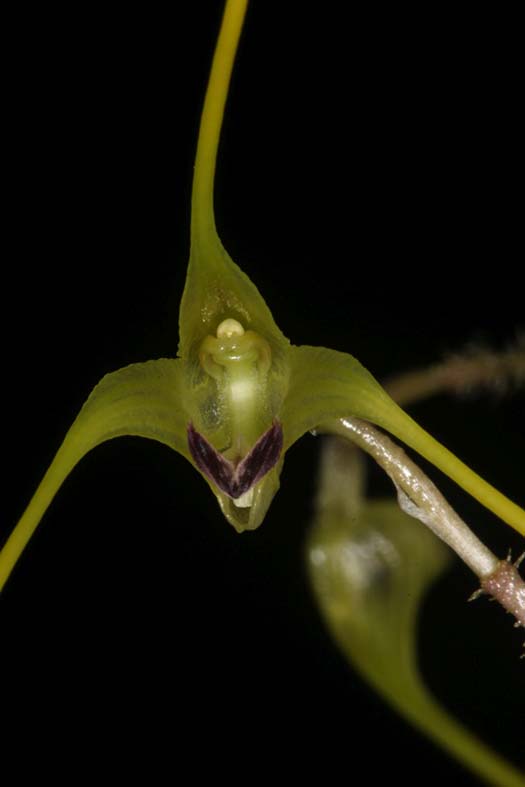 |
|
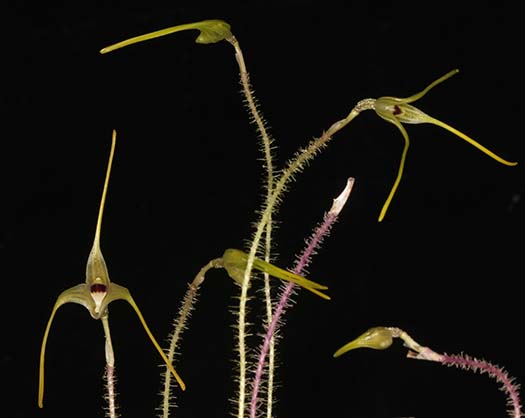 |
|
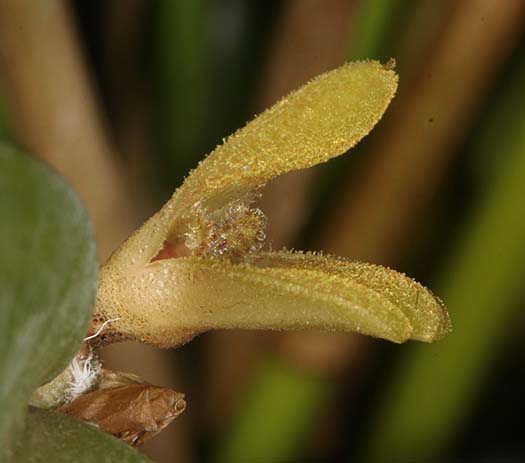 |
|
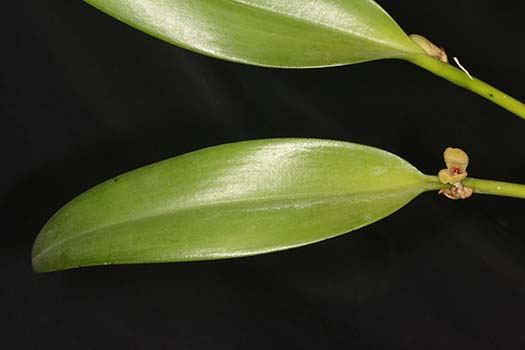 |
|
From Scott McGregor:All orchids grown outdoors, coastal southern California |
|
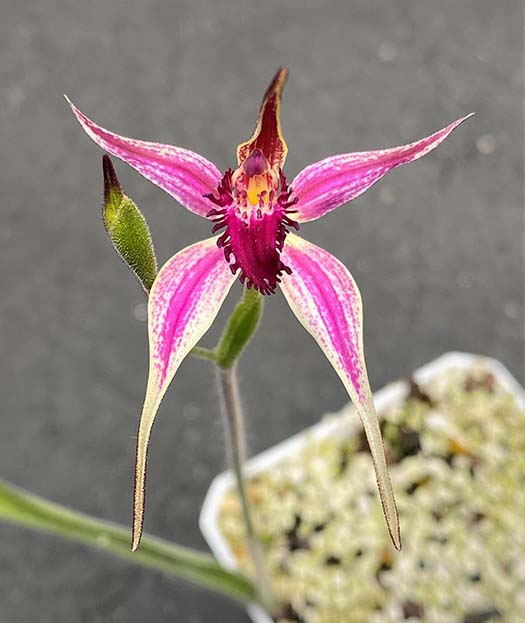 |
|
Caladenia Harlequin x speciosa(Ed. note: I am exercising editor's prerogative, and suspending the rule about showing only species for rarely-seen genera such as these Australian terrestrials that are hard to obtain and a challenge to grow. Perhaps someday the underlying species will become available in the US. But these are just too beautiful to pass up.) Lacking normal roots and supported by a network of mycorrhizae, Caladenias, called “spider orchids” in Australia, are a challenge to grow and flower. I’m not aware of any species being successfully grown in the US, as hybrid vigor seems necessary for success. Two pics of the same cross but different plants showing wide variation in this “challenging to grow” genus. Sadly the first pic with the dark red lip is from 2020 as it didn’t sprout for me this year. |
|
Diuris amplissimaA showy terrestrial “donkey orchid” from Australia, this species and D. magnifica are my favorites! |
|
Ophrys luteaNot so many flowers this year, but I’ve had this plant now for over 5 years, so easier than many! |
|
Ophrys cerastesA small but pretty Ophrys, easier to grow than some. |
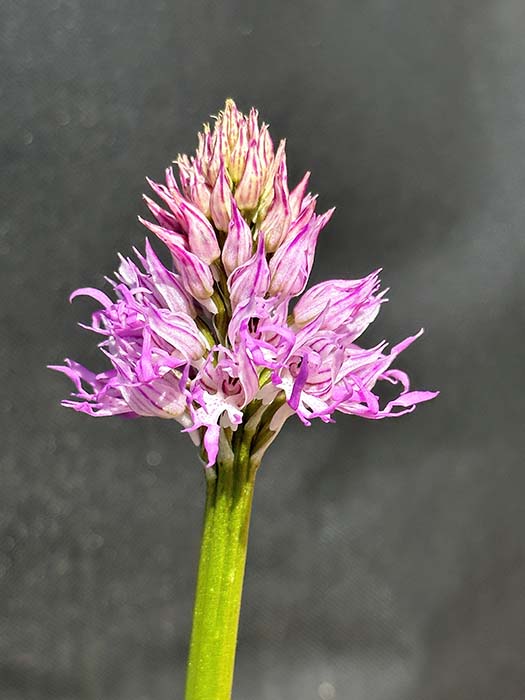
Orchis italicaThe first of my Orchis italicas to open—I’ll take more open pics (hopefully) next month. |
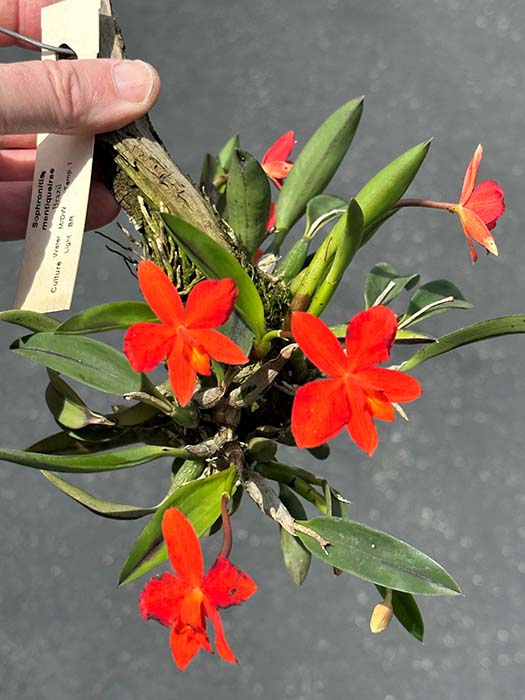 |
|
Sophronitis mantiqueiraeI know, the flowers are completely flooded and oversaturated beyond simple recovery. That’s what happens when you use a consumer camera (iPhone) to take pics of really bright orange/red flowers, since it is programmed to enhance red to get pleasing skin tones. Anyway, the flowers are very saturated in color, just not that much. And even better, it is harder to see that the prolonged rains have spoiled some of the flowers. |
Thelymitra Ron HeberleA primary cross with deep blue T. glaucophylla and wildly colored T. variegata that results in pink flowers with blue spots! I’ve sadly never seen T. variegata available in the Northern hemisphere, so this will have to do. The good news is that is one of the easier Thely’s to grow—my single small tuber from 2017 that yielded a single flower in the Spring of 2018 is now about 8 tubers, with two large ones in the pot pictured. Thelymitras only open their flowers on bright sunny days and we were lucky to have some sun this morning-- they remain closed at night and on cloudy or partly cloudy days. |
Thelymitra alcockaie x crinitaThe first of my “blue” Thely’s just opening. This one is more violet-blue than the pure blue of some of the others, but still a dramatic color. |
|
From Roberta Fox:
|
|
Outside in the Back Yard: |
|
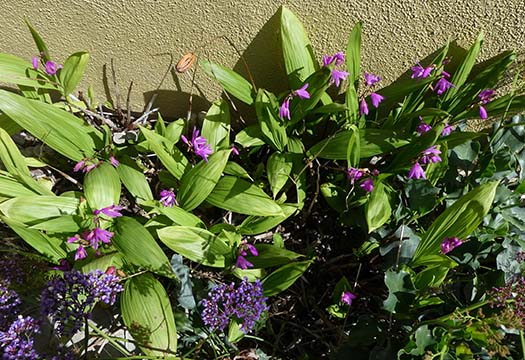 Bletilla striataThe "Asian ground orchid". These go dormant in the winter, to sprout and bloom in the spring. They are very hardy, tolerating significant frost (which isn't an issue where I live but they can be grown in more "orchid-hostile" places too). I have found that they actually do better in the ground than in pots. The clump shown above grows in a flower bed next to the purple Statice. I started it in some good potting soil, but it has spread far beyond the original hole, into the heavy adobe clay soil of the flower bed. |
|
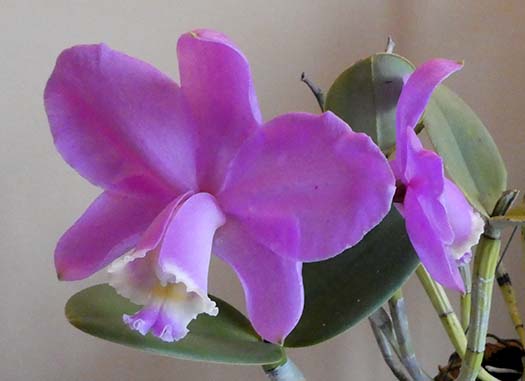 Cattleya loddigesiiNative to Brazil. This species laughs at the cold and rain. |
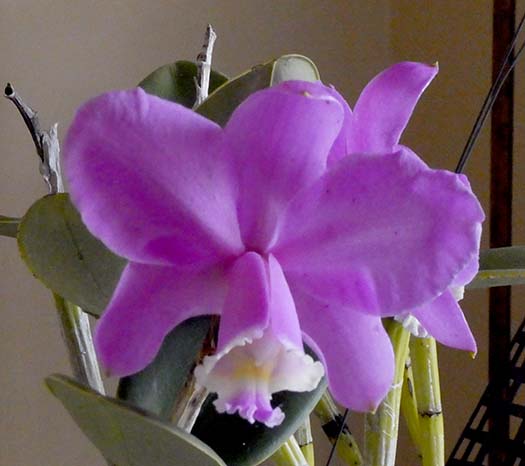 |
Caladenia HarlequinA primary hybrid of Caladenia flava x latifolia(the best that I can do at the moment), the first of the genus that I have managed to bloom. It has one leaf and not much of a root system, but this is my second year with the plant so I did get a tuber. I would love to get my hands on the parent species, to see the origin of the brilliantly saturated color. Maybe someday... |
|
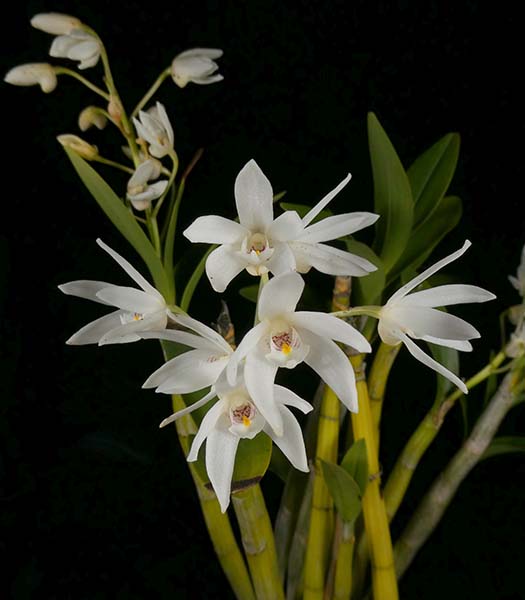 Dendrobium falcorostrumThe whole group of temperate-zone Australian Dendrobiums are putting on their annual show. This one has pristine white flowers, and powerful sweet fragrance. |
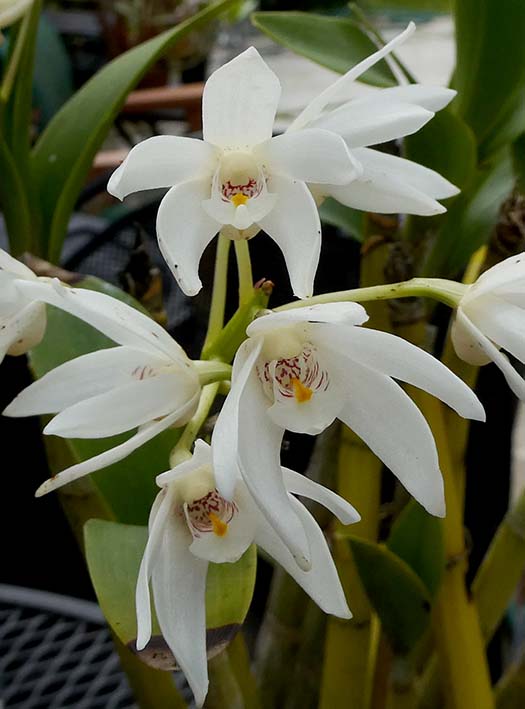 |
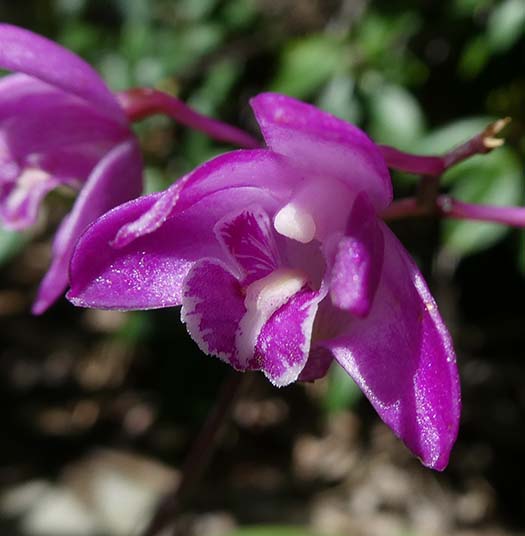 |
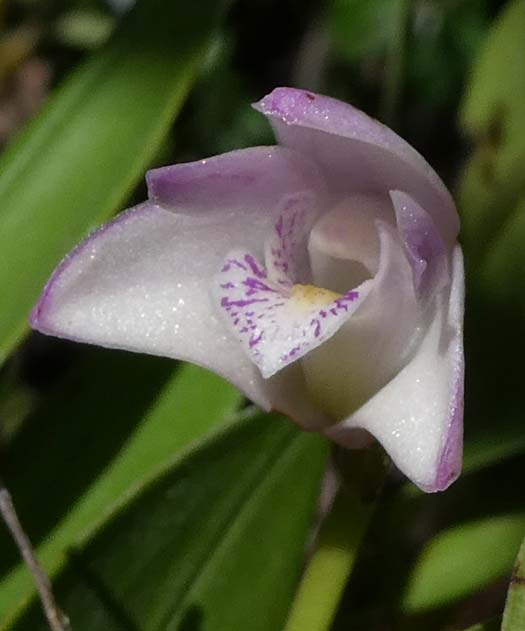 |
Dendrobium kingianumHere are just two of the many color forms of this easy-to-grow Australian Dendrobium |
|
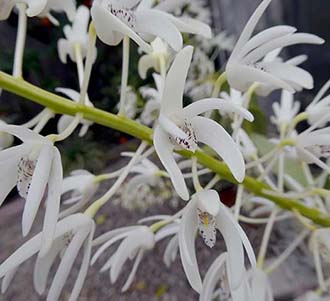 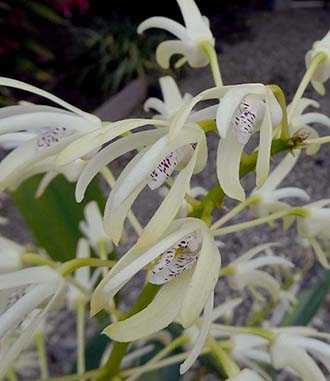 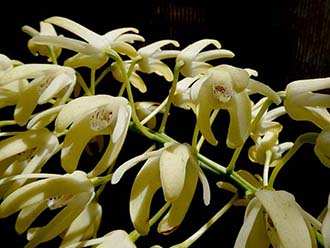 |
|
Dendrobium speciosumBig, bold, and floriforous. Color ranges from pure white to cream to various shades of yellow. Flowers only last a couple of weeks (or less if they get wet) but in the meantime, what a show! |
|
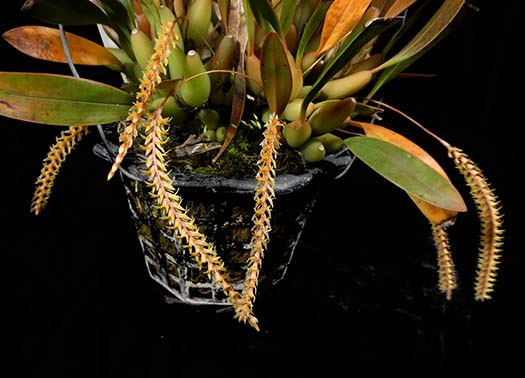 Dendrochilum pulcherrimumThis Phillipine native occurs at elevations above 1200 m. For scale, that is a 4 inch basket - small, but very beautiful, living up to its name |
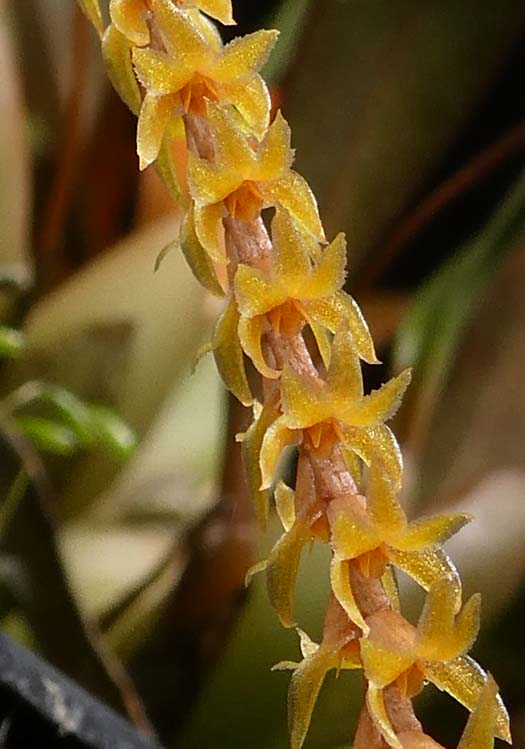 |
Diuris magnificaThis Mediterranean-climate terrestrial is native to western Australia. The genus is nicknamed the "donkey orchid". |
|
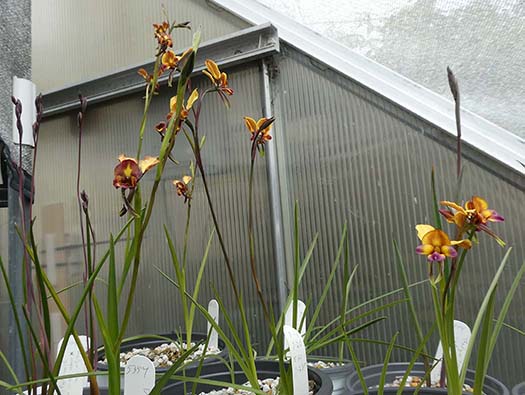
Diuris orientis and Diuris magnificaGrowing area gets several hours of direct, midday light. |
|
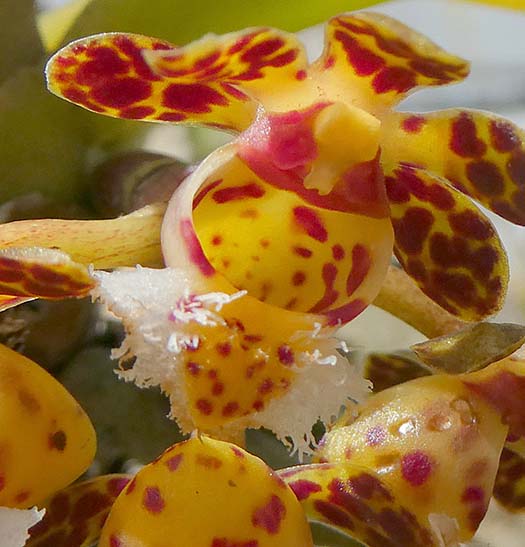 Gastrochilus calceolarisOccurs over a wide range of the Himalaya foothills, China, southeast Asia and the Philippinesat elevations from about 1000-2300 m. Flowers emerge under the leaves, so one needs to get below it to appreciate the flowers. |
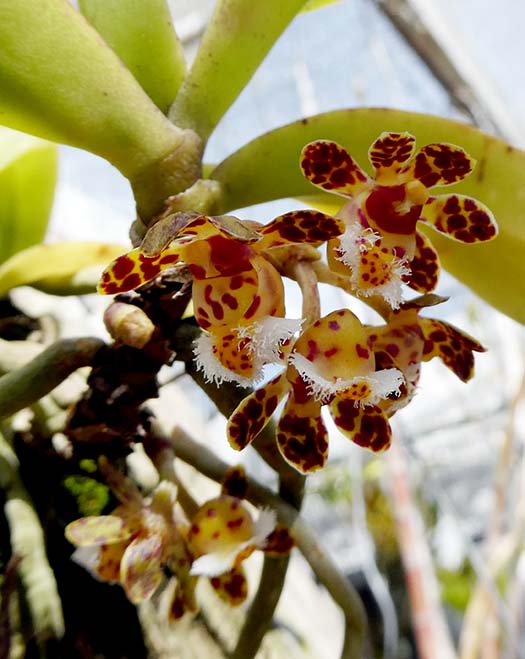 |
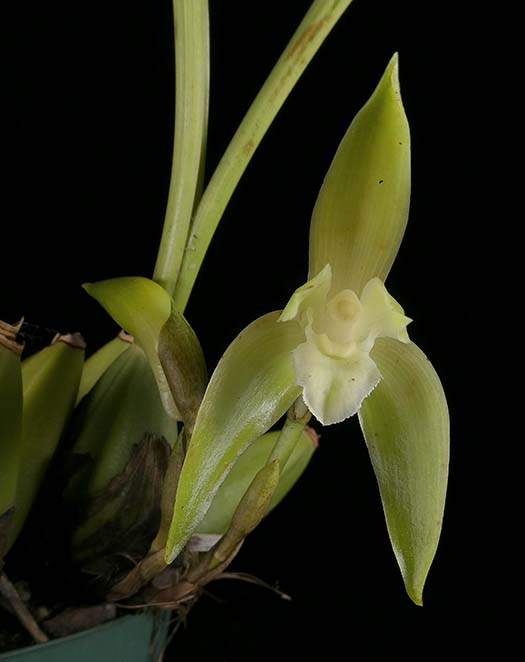
Sudamerlycaste (Ida) ciliataNative to Colombia, Peru, Ecuador and Bolivia at elevations from 1000-2500 m. Not as showy as their Central American Lycaste cousins. Flowers tend to nod downward. |
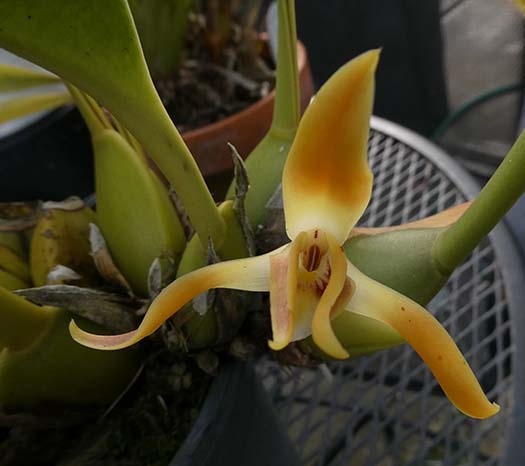
Maxillaria callichromaNative to Colombia and Venezuela, elevations 900-2600 m. Flowers have heavy substance. |
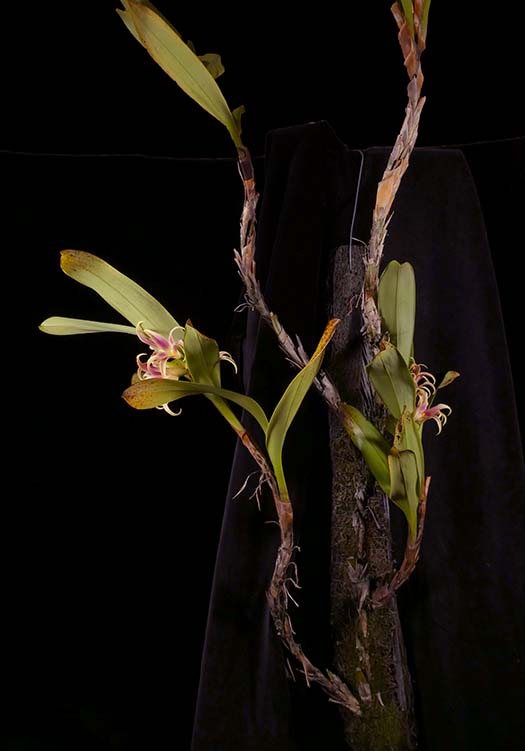 |
|
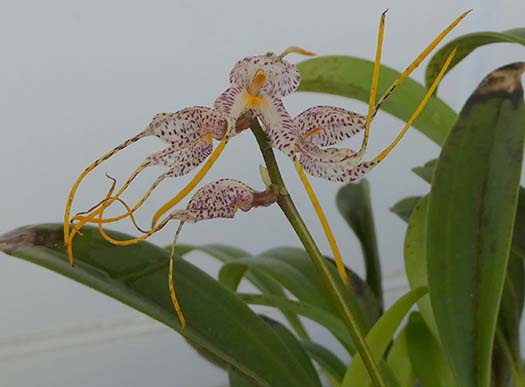
Masdevallia polystictaNative to Ecuador and Peru, elevations 1900-3000 m. The high elevation would imply that this species would have a problem with summer warmth, but I have found it to be one of my more robust Masdevallias. |
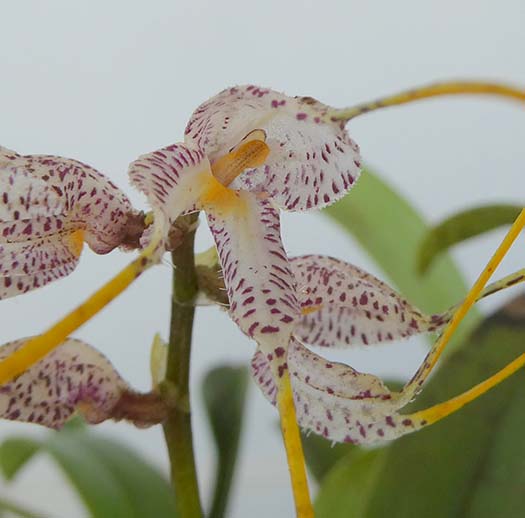 |
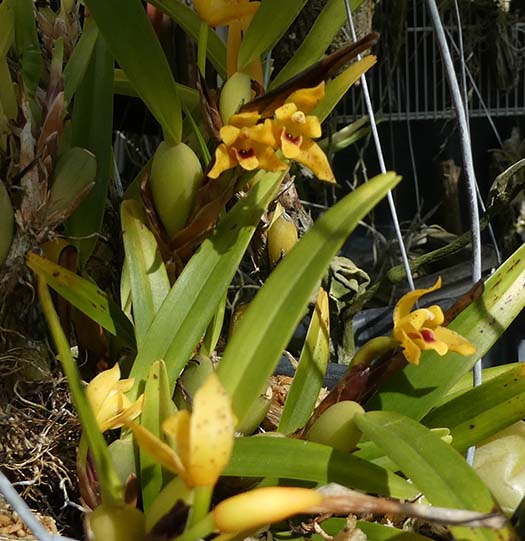
Maxillaria variabilis (yellow form)This species occurs in a range of colors from yellow to a burgundy that is nearly black. All of the forms bloom on and off throughout the year. |
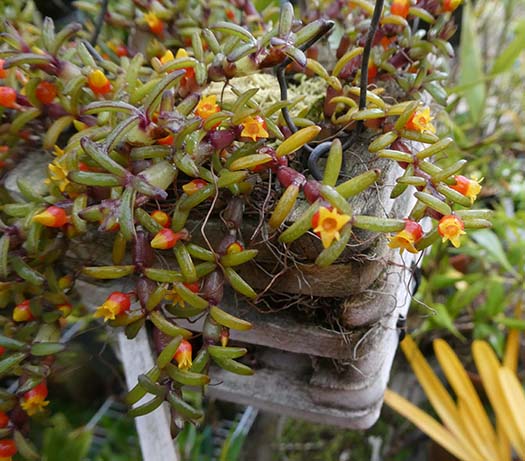
Mediocalcar pygmaeumVery similar to Mediocalcar decoratum, just with smaller leaves and flowers. |
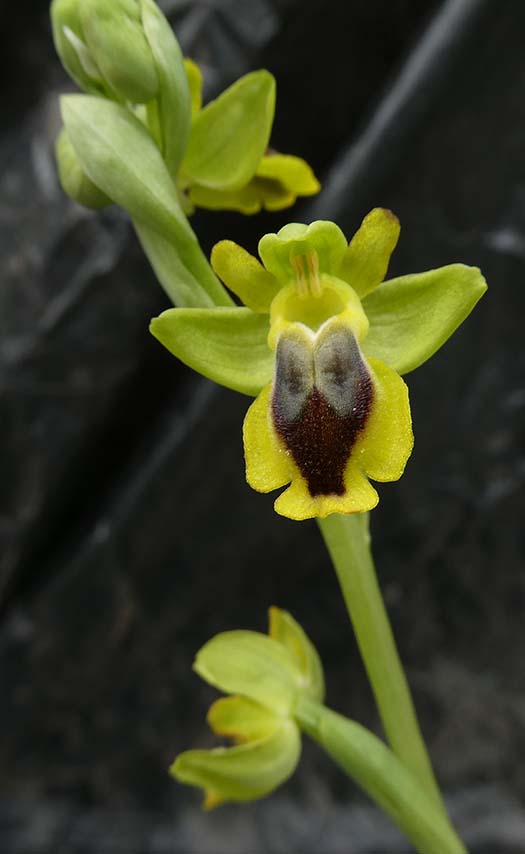
Ophrys luteaIt's the season! Me too! |
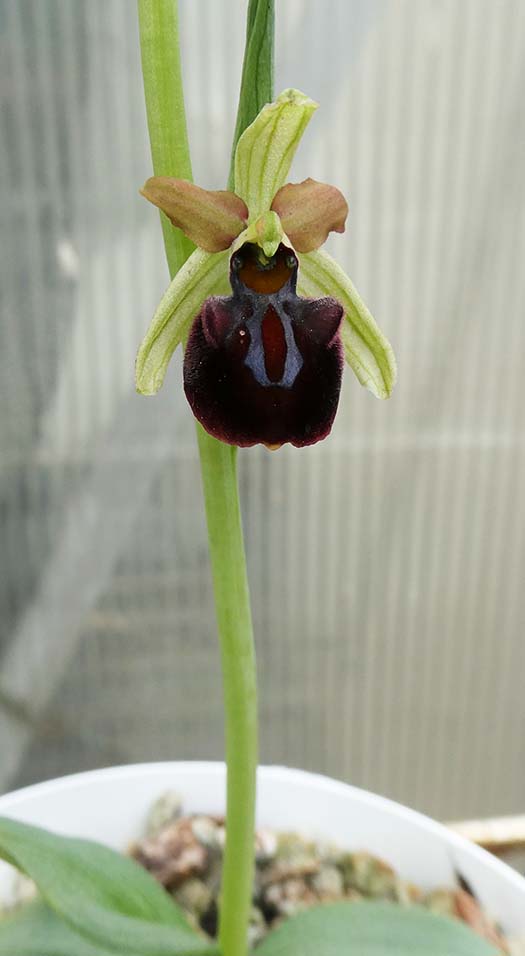
Ophrys mammosaOr Ophrys sphegodes or Ophrys sphegodes ssp. mammosa . The taxonomy of this group is messy. Ophrys spegodes complex is probably the best description. |
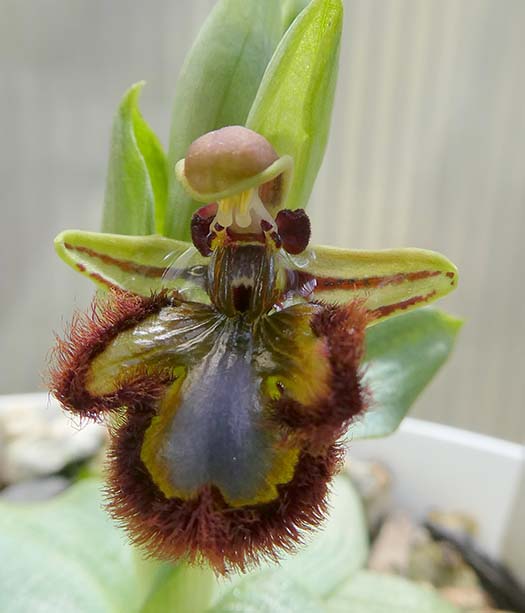 Ophrys speculumThis is one of my favorites. It is such a perfect little bug! If you were a male bee, wouldn't you think she was gorgeous? |
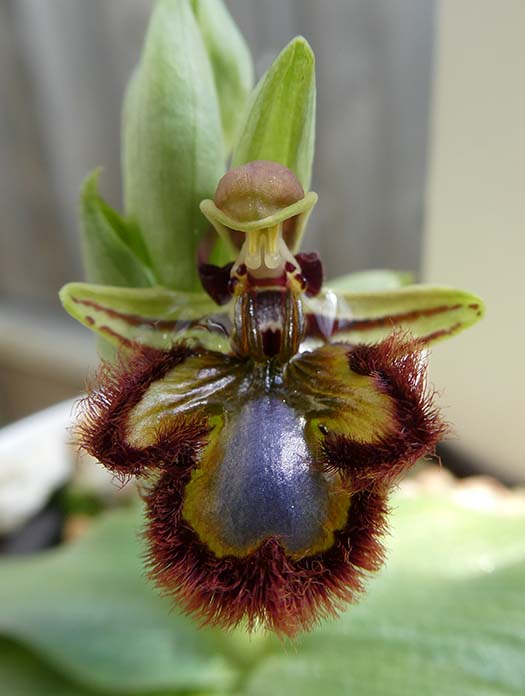 |
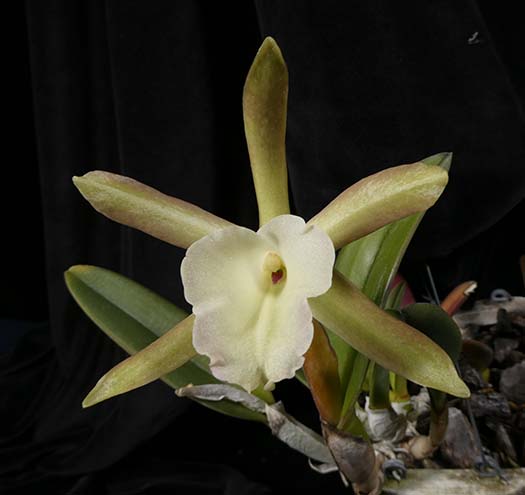
Rhyncholaelia glaucaMexico south to Nicaragua, elevations 1200-1500 m. Individual cultivars have varying amounts of pink on the segments, sometimes on the lip as well. It is fragrant at night. |
|
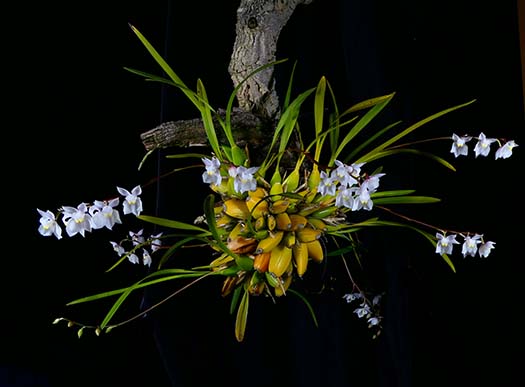 Osmoglossum pulchellumThis plant usually blooms for me in January. We had a particularly cool fall and winter, so it waited until March this year. The part of its mount that held a hanger rotted away, so I just tied what was left (the part with the plant) onto another mount. It is very fragrant, and stays in bloom for about two months. |
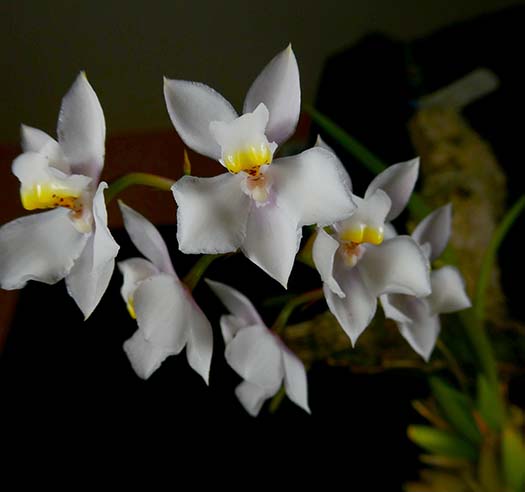 |
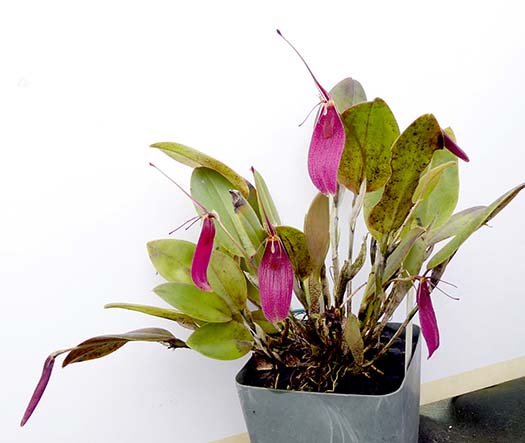
Restrepia sanguineaFlowers quite large for the genus, and lots of them on a rather small plant. |
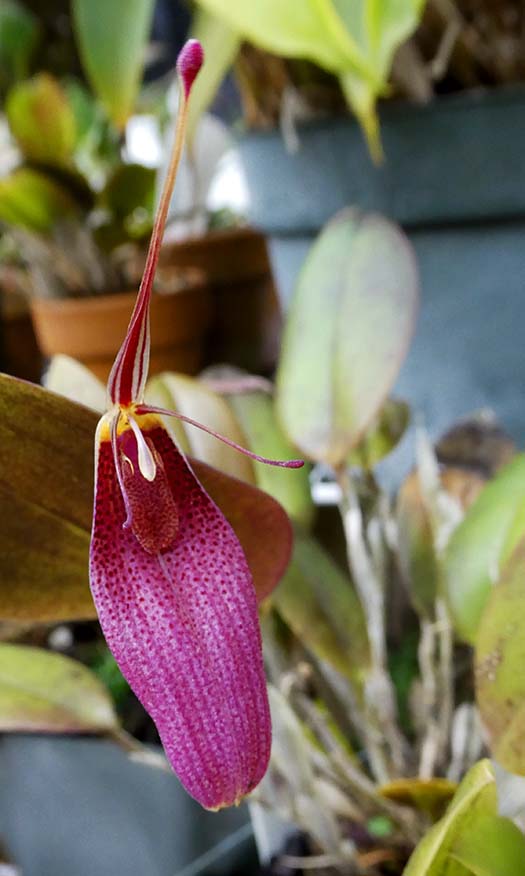 |
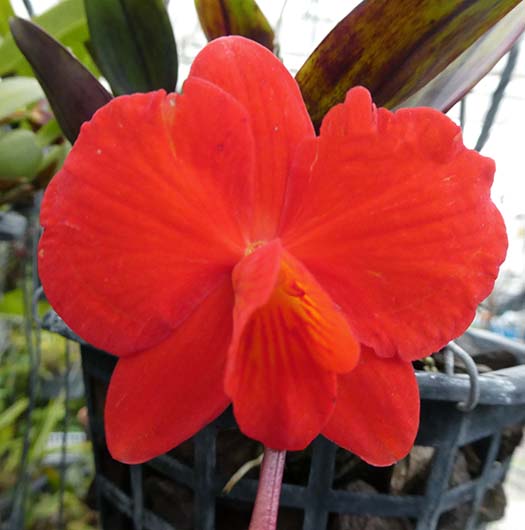 |
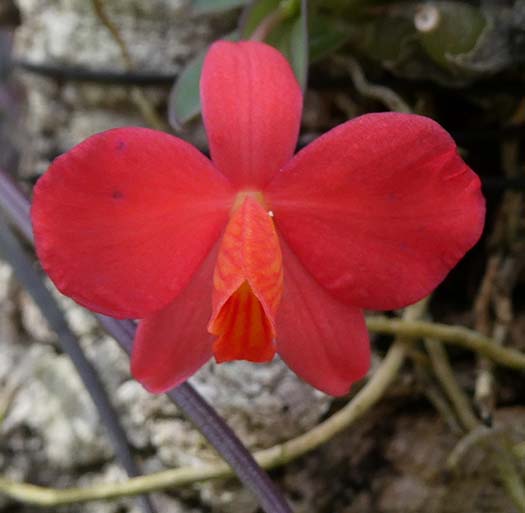 |
Sophronitis (Cattleya) coccinea 4NThis tetraploid is large, and with nice form. It got a bit beaten up by the weather, still nice. Color saturation in the photo is fairly accurate. After the flower opens, it keeps expanding for about a week or so. It is about 2.5 inches wide. |
Sophronitis (Cattleya) mantiqueiraeThe little sister... only about 3.4 inch wide. Color is a lttle ligher than S. coccinea, hints of salmon. In the sunshine, flowers have a crystalline luster. |
Sophronitis family portraitHere, you can see the size difference. S. coccinea is grand, S. mantiqueirae is very cute. |
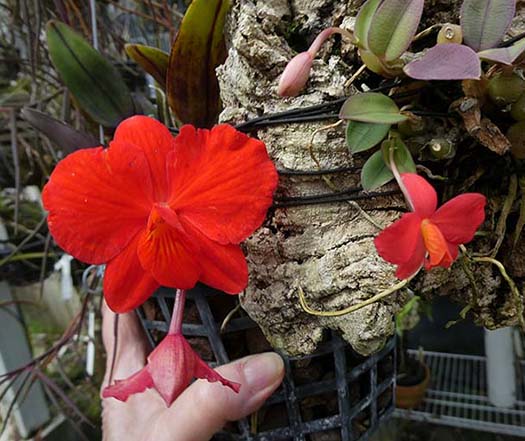 |
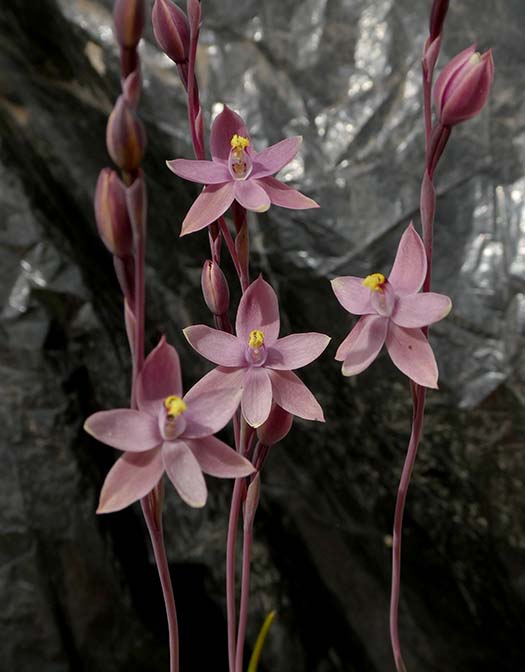
Thelymitra x-macmillanii x glaucophyllaThis is a bright red natural hybrid crossed with a very blue species. The result is sort of a "meh" color, but extremely vigorous. And the earliest of my Thely's to bloom. These only open in bright sunlight. With any cloud cover, they close up until the next sunny day. We have not had many of those, so this one has been fairly shy, and my other Thely's are waiting until next month. |
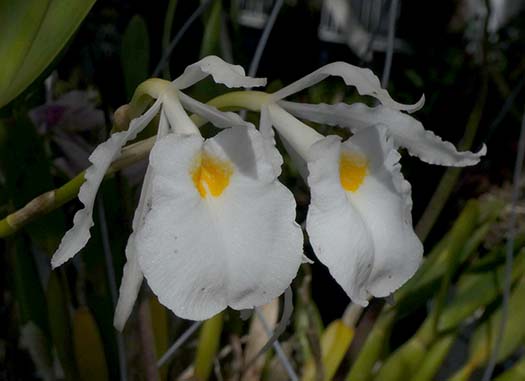
Trichopilia fragransThis is the only Trichopilia that I have been able to keep alive (and happy enough to bloom) for any length of time. Most of the genus needs a fairly narrow temperature range (disliking both winter chill and summer heat) but this one is much more forgiving. |
In the greenhouse... |
|
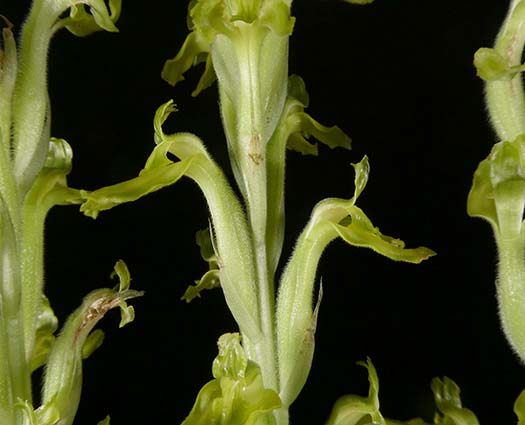
Sarcoglottis sceptrodesNative to southern Mexico and Central America. This terrestrial could grow well as a house plant, needing relatively little light. The attractive striped leaves form rosettes, and die back as the inflorescences emerge. The flowers look to me like little dragons, or maybe seahorses. It is quite fragrant. After the inflorescences die back, the new growth appears. |
|
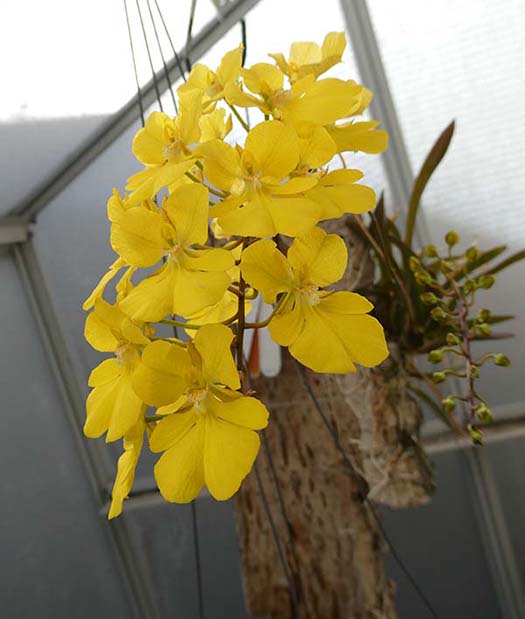
Zelenkoa (Oncidium) onustaPure sunshine. Native to western Ecuador and northwestern Peru, in areas of sparse rainfall. They grow on cactus as well as trees of dry forest. They are mostly from low elevation but collections have been made as high as 1200 m. It probably could grow cooler, but it does well in the greenhouse so that is where it stays. The mount has no moss, so it dries quickly. Flowers last two months or more. |
|
